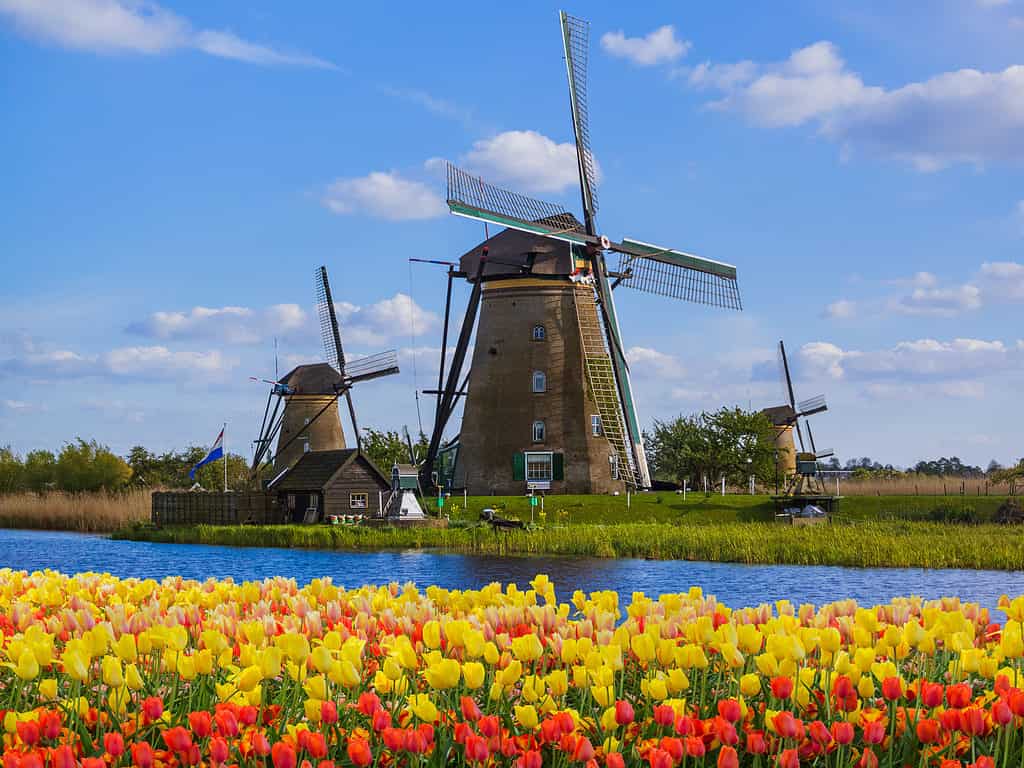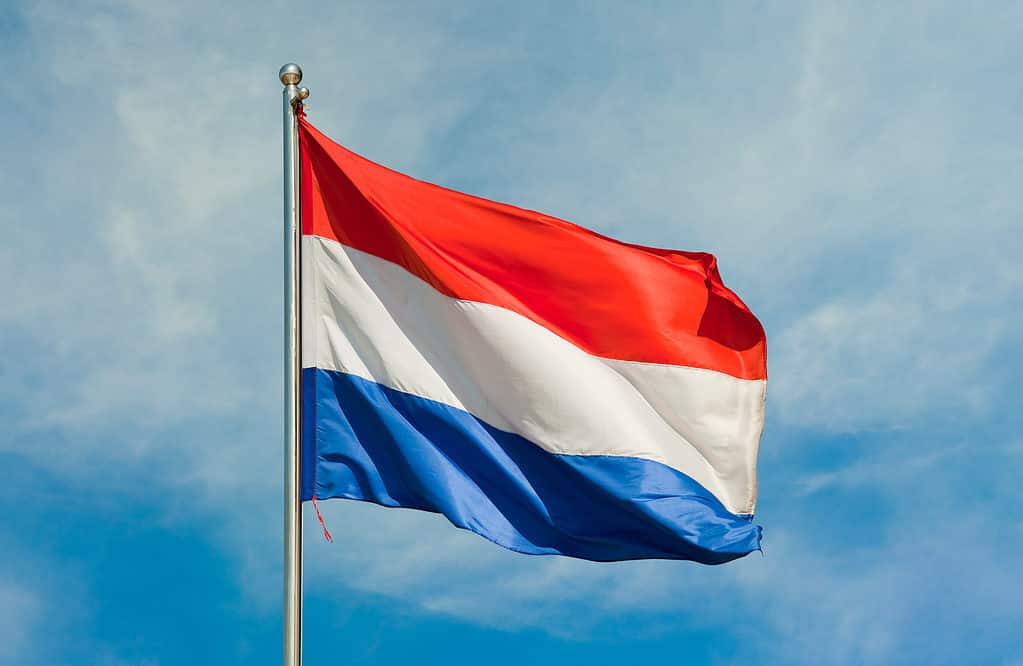The Netherlands is a beautiful country with an interesting flag and a long and deep history. The people living in this country are called the Dutch. Interesting fact, dutch men are the world’s tallest people. The country also offers lots of beautiful sights to see with miles and miles of safe bike lanes.
Did you know Netherland’s flag has changed multiple times? Keep reading to learn more about the history, meaning, and symbolism behind the flag of the Netherlands.
Where is the Netherlands?
The Netherlands is in Western Europe, sandwiched between Belgium and Germany. It also borders the North Sea. The Netherlands also has territories in the Caribbean. The territories are Bonaire, Sint Eustatius, and Saba. The surface area of the country is 16,040 mi². It is a small country, ranked 131st. Nearly 20% of its area is water. It also has 280 miles of coastline.

The Netherlands is in Western Europe, sandwiched between Belgium and Germany.
©iStock.com/brichuas
A Brief History of the Netherlands
It’s hard to understand the significance of the Netherlands’ flag without understanding its history. For the sake of this article, we are going to keep the history brief. The Netherlands is a country in northwestern Europe, also known as Holland. This country is known for many things, especially its impressive windmills and sparkling lakes, rivers, and canals.
While people have lived in the lands where the Netherlands exists today for thousands of years, the Republic of the United Netherlands wasn’t founded until 1581. Before this, the Spanish ruled over the land, and Germanic tribes originally inhabited the land. In the 1600s, the Netherlands rose to power with a strong navy. It was known as an international power and established colonies throughout the world. The Netherlands fought wars with the Spanish and English, which weakened their power. During World War 1 and 2, they remained neutral. However, in 1949, the country joined NATO, giving up its neutrality.

The Netherlands is a country in northwestern Europe, also known as Holland and famous for its windmills.
©iStock.com/TPopova
The Current Flag of the Netherlands
The flag of the Netherlands has seen a lot of change, but it looks strikingly similar to the Prince’s Flag used in the 16th century. Currently, the flag of the Netherlands is a horizontal tricolor of red, white, and blue. Interestingly, the flag has inspired many others like the flag of the South African Republic, the Republic of Klip River, the Republic of Swellendam, and New York City. The current national flag is flown with pride at government buildings and military bases all year long. While it’s uncommon for citizens to fly the flag privately, on birthdays, graduations, and special occasions it’s flown, but accompanied by a pin or the graduate’s school bag.

The flag of the Netherlands (Dutch flag) is a horizontal tricolor of red, white, and blue.
©iStock.com/macky_ch
Meaning and Symbolism of the Netherlands Flag
There are two theories on what each color and stripe means. The first theory states that the red band means bravery, strength, valor, and hardiness. Next, the white band represents peace and honesty, while the blue symbolizes vigilance, truth, loyalty, justice, and perseverance. This is the most accepted meaning. However, some researchers believe the colors were chosen because of their meaning in society. For example, the color red is the people, white the church, and blue the nobility.
Historical Flags of Netherlands
There were at least 3 other flags used before the most recent one, each with their own unique twist. Keep reading to learn some fun facts about each flag.
The Cross of Burgundy Flag
During the Middle Ages, the cross of burgundy flag represented provinces in the Netherlands united under the Duke of Burgundy. The flag features a saw-toothed red version of Saint Andrew’s cross. The background of the flag is white, emphasizing the cross.
The Prince’s Flag
The second flag on this list is the Prince’s flag, which is very similar to Netherlands’ current flag. It features three stripes, but instead of red, the first band is orange. This flag became popular in the late 1500s. It’s considered the first “real” Dutch flag. The colors were recorded in the siege of Leiden in 1574. Vruntschap of Jan van Hout (1575) is the oldest known illustration of this flag in color. On the image, it sits on the top left.
The Statenvlag Flag
The orange band on the flag was replaced quickly by 1596, but it wasn’t popularly accepted or used until after 1630. At the time, red symbolized a political change, which was shifting in the country. The flag was referred to as “the Flag of Holland”, but its name changed after a complaint in 1664. From then on, it was referred to as the Statenvlag flag, also known as States Flag. The Statenvlag was recorded in many paintings and flown everywhere, alongside the Prince’s flag. However, in 1937, Queen Wilhelmina signed a royal decree declaring the colors red, white, and blue were the official colors on the Netherlands flag.
Click here to learn about every single flag in the world!
Up Next
- The Flag of Paraguay: History, Meaning, and Symbolism
- 29 Different Countries with Red, White, and Blue Flags
- The Flag of Cote d’Ivoire: History, Meaning, and Symbolism
The photo featured at the top of this post is © iStock.com/flowgraph
Sources
- Britannica, Available here: https://www.britannica.com/topic/flag-of-the-Netherlands
Thank you for reading! Have some feedback for us? Contact the AZ Animals editorial team.







